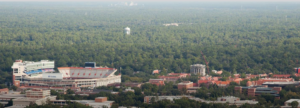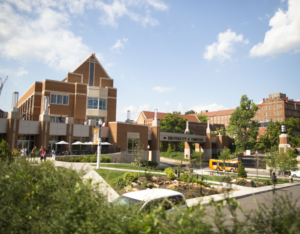The U.S. Department of Education (DOE) is spearheading a federal initiative to make STEM curriculum (science, technology, engineering and math) a fundamental priority in America’s education system. Federal officials will increase funding to support the implementation of high-quality STEM programming for students.
The new federal initiative is already having a noticeable impact on public university campuses. The escalating support is resulting in large construction projects. New academic buildings and student housing facilities are in development across the country to accommodate the increasing demand for STEM programming. Many of these projects are categorized as mega buildings.
The state of Tennessee recently issued guidelines for such projects. The guidelines identify planning priorities such as collaborative space, research areas, etc. Administrators at the University of Tennessee at Knoxville recently unveiled a campus construction plan that features several new construction projects with budgets exceeding $100 million. The plan also includes student housing construction projects.
Near-term projects programmed for the next five years are projected to generate approximately one million square feet of newly constructed academic and research space along with more than 441,000 square feet of new student housing construction. In the mid-term, the university’s plan includes new construction projects that will yield 1.3 million square feet of new physical space for academic and research programming. One of the largest projects in the university’s construction pipeline is a proposed interdisciplinary research facility that is expected to cost $238 million. Additionally, the university has announced plans for an indoor baseball practice field that will likely be delivered as a public-private partnership (P3).
Large construction projects with individual price tags exceeding $100 million will launch soon on the University of Florida’s campus. One project is a $215 million biomedical and life sciences research building which is currently in the design phase. The multidisciplinary facility will be equipped with resources and specially designed space to support the university’s continued progress in the field of biomedical research. The project is scheduled to launch in 2024 and be completed by 2026.
As new investments in student housing and STEM learning transform college campuses throughout the U.S., the University of Colorado Boulder is an example of what is happening. Administrators are planning several large construction projects for the university system’s main campus. A $169 million chemistry and applied math building is almost ready to launch. The 4-acre site of the facility will offer significant visibility and distinguish the building as a gateway to the rest of the campus. Construction is scheduled to begin in 2024.
Between 2024 and 2025, the university also plans to begin construction on two different residence halls that will extend the limits of the campus into the North Boulder Creek region. The first residence hall, which will also be launched in 2024, will offer approximately 190,000 gross square feet of housing. The second of the proposed residence halls will be launched the following year and offers 176,000 square feet of new residential space. Each project carries an estimated budget of $116 million.
At the end of April, Washington’s state legislature approved a capital plan that authorizes significant funding for STEM research and learning facilities. A $40 million appropriation from the state will support the design and construction of a proposed Engineering Student Success Building on Washington State University’s main campus in the city of Pullman. The 85,000-square-foot facility will offer services such as advising, tutoring, teaching and other resources for collaboration. The project is scheduled to begin in 2024 and is scoped for progressive design-build delivery. This is only one of many STEM-related academic building projects in development for the Pullman campus.
In Nevada, state lawmakers are ramping up investments in STEM construction at several public universities to curtail an ongoing, statewide exodus of doctors, nurses, and teachers. A $14 million allocation of state funding for the University of Nevada, Reno will cover costs for the planning stage of a life sciences building. It is considered essential to Nevada’s broader workforce development goals. The 80,000-square-foot facility will be located in the center of the campus’s expanding gateway district. University officials have estimated that the project’s total cost will reach $138 million.
A $160 million construction project planned for Purdue University’s campus in West Lafayette, Ind., will expand STEM resources according to the institution. State lawmakers recently approved an initial $89 million appropriation to kickstart planning work on the Nursing and Pharmacy Education Building. The facility will expand multidisciplinary STEM programming within a simulated, modern health care setting. The building will also place greater emphasis on collaborative learning spaces. It will be structured with resources to prepare the next generation of health care professionals in Indiana for an industry defined by scientific breakthroughs and technological innovations.
Officials at the University of Iowa are seeking approval from state lawmakers to launch the planning stage for new STEM-related projects that will support the College of Pharmacy and Pharmaceutical Science curriculum. The project entails construction of new specially designed laboratories to encourage bioscience research and medical innovation.
The funding and technical support available for projects on university campuses is historic and the trend is expected to continue. America’s global competitiveness is closely tied to a trained and skilled workforce. Many extremely large collaborative initiatives are in the initial design stages.








